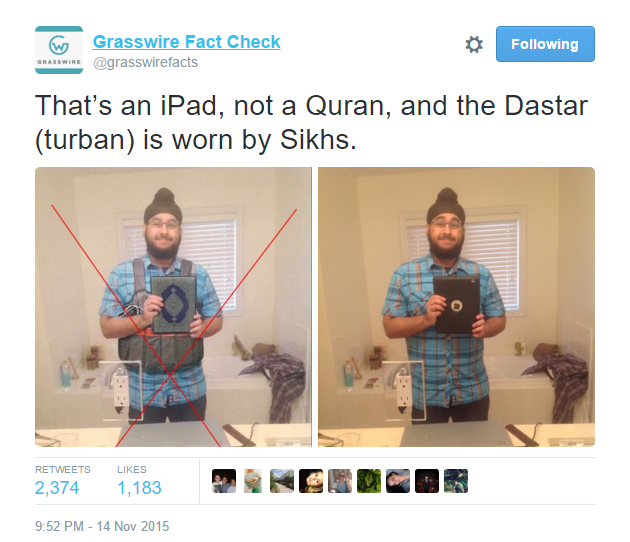The soul-searching began last week, as more and more cases emerged of established media outlets falling for false news on the Paris attacks.
The most grotesque example is probably that of the transformation of a grinning selfie by Veerender Jubbal, a Sikh man who lives in Canada, into a photo of a possible ringleader of the attacks. The photo made it on the front page of La Razón in Spain, was carried in Italy by news wire agency ANSA and by Sky TG24. At the time of writing, a full nine days later, the manipulated photo is still on Sky TG24’s Twitter profile, which has nearly 2 million followers.
That’s an iPad, not a Quran, and the Dastar (turban) is worn by Sikhs. pic.twitter.com/xkKzJ0G65f
— Grasswire Fact Check (@grasswirefacts) November 14, 2015
In a piece for First Draft News, Claire Wardle, research director at the Tow Center for Digital Journalism, set the challenge clearly: “If news organisations don’t start fighting false information as it happens we risk losing our audience to the lies.” Wardle concludes her thoughtful article with an urgent call to action: “Asking everyone to run a reverse image search before they re-share an image on social media is not working. It’s time we look again at possible solutions.”
I am a little bit more optimistic about the situation, even as the challenge is undoubtedly great. With the Paris attacks coverage, we saw massive amounts of fake news but also a great increase in active debunking, with fact-checkers in France on the front line. Following Le Monde’s Décodeurs, Libération’s Désintox, Buzzfeed France’s Vérifié, France 24’s Observateurs or Hoaxbuster.com you could navigate your way out of much of the noise. As Alastair Reid of First Draft News recently wrote, these efforts paid off in terms of traffic, too.
Secondly, supporting readers and other reporters in their own debunking efforts should remain a fundamental mission for journalists in general and fact-checkers in particular. There is just too much false information out there for media outlets to do everything. Even when they arrive promptly, media debunkers rightly concentrate on the more widely shared lies and miss plenty of other falsehoods.
Ten days ago, before the Paris attacks, I spoke to Paolo Attivissimo, an Italian debunker. Much like the US-based Paulo Ordoveza, who runs @PicPedant, Attivissimo debunks viral photos. He also takes issue with ridiculous headlines. Attivissimo has a huge following on Twitter and a popular blog; having been at it for more than ten years, he is somewhat of a legend among Italian fact-checkers.
Attivissimo’s blog is not how he makes a living – he is a journalist and a translator, among other things – though he does receive micro-donations, which he mostly spends on pizza. With Attivissimo’s help, I compiled a list of tips for DIY debunking for keen amateurs or journalists who haven’t had any training in verification or fact-checking. It is neither exhaustive nor unprecedented. However, as fact-checkers dedicate more time to spreading the practice beyond their sites, it is helpful to do so in practical terms.
1. First, do no harm
Before you even start debunking, make sure you are not sharing false rumors yourself. Avoid becoming one of the thousands who give credence to a false tweet by retweeting it. Décodeurs published a basic guide following the Paris attacks with suggestions on how to consume news on social media more responsibly.
2. Use custom searches
If you want to ascertain whether something is true or not, Attivissimo suggests starting with a custom search on Google that only draws from debunking sites and other sources you trust. Filtering the noise of a simple search will help you get to the truth faster. To do this, structure you search on Google in the following way:
Word/phrase searched site:debunking1.org OR site:debunking2.com
3. Learn basic photo-checking
Seriously. If you use Chrome, you are just one right-click away from seeing whether an image already circulated in the past. Even on other browsers, all it takes is dragging and dropping the photo into Google images. If the photo has been around for over a year, then you can be sure it was not taken “tonight in Paris”. Attivissimo also uses Tineye.
4. Don’t flatter yourself into thinking you’re a fast learner
Attivissimo calls it “sindrome dell’apprendimento facile” (the easy-learning syndrome). This may be one of the most important challenges for the more conscientious users of social media. I have caught myself doing this several times: once you have skimmed through a couple of reliable sources and have the basics covered, you fool yourself into thinking you have come to grips with the subject. You likely have not. As a further step, Attivissimo suggests having a “human search engine;” go-to people that you can consult to double-check your findings. Experts are often keen to set the record straight; you will be surprised how likely they are to respond to a tweet aimed to debunk to online misinformation in their field of expertise.
5. Find someone on the ground
Someone who is in the location of interest will not do the debunking for you, but s/he can help you with crucial context. You don’t need to be part of a news bureau with a correspondent in place to be able to do this. Twitter doesn’t just spread fakes; it is also a place to create a network of people whose trustworthiness you can evaluate. Do you have a friend in Paris? A journalist whose background you know well? If the answer is no to both of these questions, you can still use Twitter’s geolocation options to find eyewitness media, even as this can be obviously trusted less. Through these channels, you can confirm simple but crucial details such as what the weather is like or whether the Tour Eiffel turns its lights off every night after 1AM. This helps corroborate any evidence you have already found.
6. Don’t expect to reach everyone
Unlike PicPedant, who has said social media image debunking is “a futile and hopeless endeavor akin to banging one’s head against a brick wall,” Attivissimo is more hopeful. He recognizes that spreading fake information is an actual business for some, and that a debunker is fighting an uneven war. Yet he doesn’t see it as a lost cause. “Online, the important thing is that the correct information be somewhere out there. The important thing is that someone who wants to find the truth can find it”.
Which brings me back to the top. Yes, media outlets need to fact-check more – but to a lesser extent, so do media consumers.







